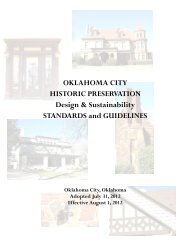OKC Plan, 2000-2020 - City of Oklahoma City
OKC Plan, 2000-2020 - City of Oklahoma City
OKC Plan, 2000-2020 - City of Oklahoma City
You also want an ePaper? Increase the reach of your titles
YUMPU automatically turns print PDFs into web optimized ePapers that Google loves.
Coordinated by: Community Appearance Coalition and <strong>City</strong> <strong>of</strong> <strong>Oklahoma</strong> <strong>City</strong> <strong>Plan</strong>ning<br />
Department<br />
Also involving: other <strong>City</strong> departments; development pr<strong>of</strong>essionals; neighborhood and business<br />
groups; individuals and groups concerned with community appearance<br />
Review/Approval by: <strong>Plan</strong>ning Commission and <strong>City</strong> Council<br />
Budgetary requirements/implications: up to $100,000 for consultant services for each planning<br />
effort (Gateways, Downtown, <strong>City</strong>-wide); public-private sharing <strong>of</strong> costs may be a possibility<br />
<strong>Plan</strong> policies:<br />
• Conduct appearance plans for gateways/corridors, Downtown, and city-wide to develop<br />
policies and programs for improving the <strong>City</strong>’s appearance. (Community Appearance)<br />
• Increase landscaping requirements and establish standards for landscaping. (Land Use and<br />
Design; Community Appearance)<br />
• Strengthen code enforcement throughout the <strong>City</strong> and move toward a pro-active rather than<br />
complaint driven program. (Housing and Neighborhood Revitalization; Community<br />
Appearance)<br />
• Adopt standards for the appearance <strong>of</strong> commercial and industrial structures along designated<br />
gateways. (Community Appearance)<br />
• Develop comprehensive design guidelines for all elements <strong>of</strong> <strong>City</strong> capital projects.<br />
(Community Appearance)<br />
• Review appearance problems in rural areas and change <strong>City</strong> codes and enforcement practices<br />
as appropriate to address the specific needs and characteristics <strong>of</strong> rural areas. (Community<br />
Appearance)<br />
Public Services<br />
Explore regional cooperation in providing public services.<br />
Schedule: Initial contacts with ACOG and other service providers should begin during<br />
FY <strong>2000</strong>-2001. Discussions would continue during subsequent years with regionalization <strong>of</strong><br />
selected public services dependent on a satisfactory resolution <strong>of</strong> details.<br />
Coordinated by: Initial contacts would be made by <strong>City</strong> departments involved in delivering<br />
services<br />
Also involved: ACOG; other cities and service providers<br />
Review/Approval: <strong>City</strong> Council to authorize <strong>City</strong> participation in newly-created regional<br />
organizations or to expand the services <strong>of</strong> an existing <strong>City</strong> department or agency to provide<br />
region-wide services, and to fund the <strong>City</strong>’s share <strong>of</strong> a regional organization’s expenses.<br />
Budgetary requirements/implications: There is a possibility that regionalizing services could<br />
lead to cost savings. Expanding existing <strong>City</strong> operations to serve the region would lead to<br />
increased costs, but would provide additional revenues for enterprise services.<br />
<strong>Plan</strong> policies:<br />
Policy statements supporting this action are contained in the Public Services and Regional<br />
Context elements.<br />
117

















